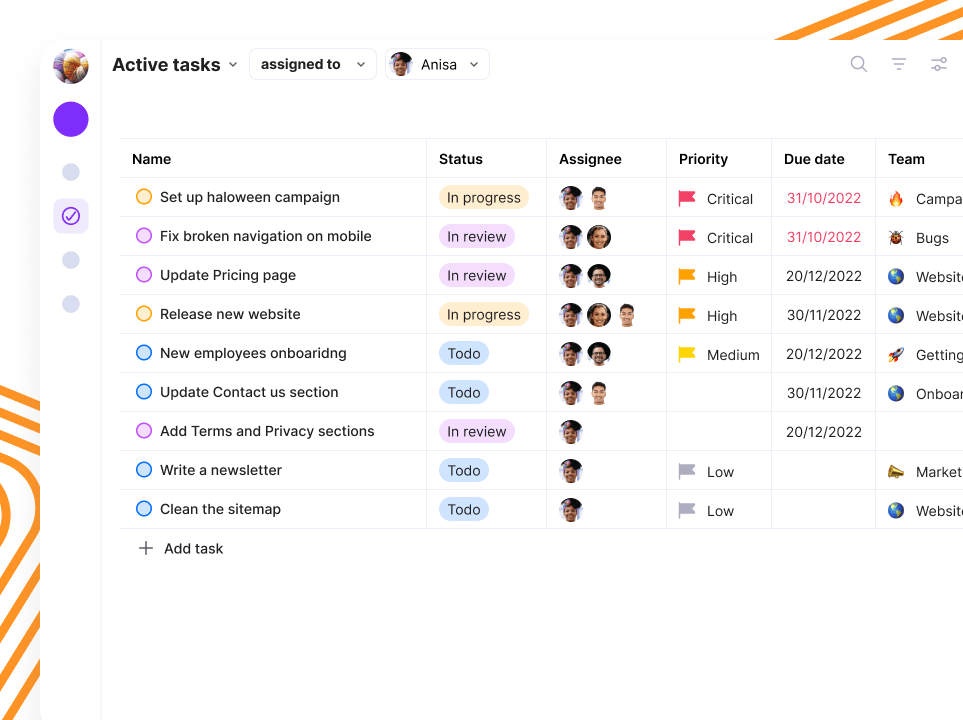

The Power of Checklists: Train Your Brain for Productivity and Goal Achievement
How do you keep track of all your tasks and responsibilities in the workplace? Is your working space covered in countless sticky notes, or do you keep lists of all your duties on your phone? Maybe you’ve discovered one of the task-management platforms that enable creating handy checklists for staying on top of your tasks.
Regardless of your preferred method , one thing is sure – keeping track of tasks is crucial for prioritizing, delegating, and finishing tasks to ensure everything in the business runs smoothly. Whether you’re a CEO, freelancer, or company employee, each role comes with its unique duties and responsibilities.
With the power of checklists, you can increase your productivity easily and achieve various goals quickly. These lists have plenty of other benefits, which we’ll cover here, so read on.
The history and evolution of checklists
When we say checklists, your first association is most likely a grocery list you’ve probably created for many of your grocery store runs. However, checklists have many other use cases and goals in professional and daily life. In fact, the first checklist was used in aviation.
After the crash of Boeing’s Model 299 plane on October 30, 1935, due to the simplest mistake of pilots forgetting to release the flight control gust locks, Boeing realized they had to do something to ensure nothing similar happened again. The technology of new airplanes was getting too complex even for the most talented pilots, so it was becoming increasingly difficult for them to memorize all the steps.
That was when Boeing introduced a checklist – a permanent and mandatory tool for pilots to verify they follow all the required steps during a flight. However, its use quickly spread to other areas in aviation, so now there are plane production checklists, maintenance checklists, and flight attendant checklists.
Today, checklists are everywhere in the aviation industry and other industries, like healthcare, architecture, marketing, education, and IT.
Cognitive benefits of using checklists
A simple checklist has numerous benefits you can count on in the workplace. Whether you’re creating daily checklists for repetitive tasks or want to ensure that the big project you’re working on runs as smoothly as possible, these lists can equip you with all kinds of advantages. Here are some of the benefits of checklists.

Increase productivity
Trying to memorize all your tasks is pointless when you can create a checklist that records all your repetitive tasks. That allows you to spend less time trying to remember what you need to do and more time doing it.
As a result, you can quickly increase productivity and complete tasks more efficiently. That is especially true if you’re using productivity tools like Ayanza that automate and streamline plenty of processes for you.
Reducing the likelihood of errors
A task list is the easiest way to reduce errors. Whether you want to ensure you complete all processes in the correct order or remember all activities, a checklist does the trick.
Also, this list helps you meet all the requirements for every task you’re working on, so it eliminates or at least reduces the likelihood of an error. Use Ayanza or some other digital tool to implement AI into your workflow and work in the most optimized way.
Boost creativity
It’s challenging to work on tasks that require you to be creative when you’re overwhelmed with routine tasks that take a lot of time and energy. Fortunately, checklists help boost your creativity by taking care of your everyday tasks, which gives you more time to focus on the more important stuff.
Moreover, numerous modern checklist apps come with rich content editors that allow for cross-team collaboration and optimized task management, further boosting creativity for many employees by keeping them motivated and engaged in their work.
Maintain organization
Leading a hectic business life isn’t easy, especially since it requires you to stay organized at all times. While businesses thrive on organization, it’s nearly impossible to maintain the same level of focus and dedication if you’re not using a system that keeps track of all your essential tasks.
For instance, Ayanza allows you to set the lifecycle of every task, see who’s working on what, and manage all your responsibilities from one place. Having access to such a powerful and versatile tool makes it significantly easier to maintain the highest level of organization from month to month.
Achieve excellence
Using a workplace checklist equips you with many advantages that translate to excellence in the eyes of business partners, sponsors, and customers. When everything your team does is of outstanding quality, your partners and clients will acknowledge that.
A simple tool that allows you to create checklists already equips you with the required services, but an advanced tool like Ayanza takes it to another level.

Using checklists in different industries
As you now know, the aviation industry used the first checklists. Today, many types of checklists exist to respond to the different demands of different professions and industries. Here’s how the lists help with various task requirements.
Aviation
In aviation, checklists are a systematic and comprehensive tool to ensure the safe and efficient completion of tasks before, during, and after a flight. They serve as memory records and help pilots follow standard procedures, verify equipment and systems are functioning correctly, and identify potential problems.
Checklists are helpful in various stages of flight, including pre-flight preparation, takeoff, in-flight operations, landing, and shutdown procedures.
They minimize the risk of human error during these complex tasks and provide a consistent approach to problem-solving, resulting in increased safety and efficiency in flight operations.

Healthcare
Healthcare checklists improve patient safety, quality of care, and efficiency in various medical procedures and settings. They help healthcare professionals complete all necessary steps and ensure they miss no critical tasks in the process.
Some examples of checklists used in healthcare include surgical checklists, hand hygiene checklists, patient handoff checklists, and emergency response checklists. Nowadays, healthcare organizations have an array of top-grade healthcare project management solutions for helping medical staff improve their workflow and simplify everyday activities.
Construction
Checklists in construction to ensure the optimized completion of tasks and reduce the risk of errors and oversights. They verify that all necessary steps are taken, materials and equipment are available and in good condition, and safety procedures are followed. There are pre-construction checklists, safety checklists, quality control checklists, and punch list checklists for additional tasks.
Besides ensuring construction workers take all the necessary steps and complete their work efficiently and effectively, construction checklists ensure all quality and safety standards are maintained.
The powerful role of checklists
Considering checklist forms come with so many advantages that even the most demanding and complex industries rely on them, it’s safe to say they have a powerful role. Nevertheless, their usefulness excels in quality control and risk management.
Quality control
Checklists are excellent tools for quality control because they guarantee every business process meets the established standards and specifications, which results in a higher quality of the final products and services. With checklists, companies can easily maintain the high level their brand is known for by verifying all day tasks meet the set requirements.
Thanks to inspection, testing, and process checklists, businesses can optimize their quality control and surpass companies that manually check their products, services, and processes even though their employees might have a decade of experience in the field.
Risk management
Oversights happen to employees even with a ton of experience, which can lead to dangerous, costly, or hazardous situations. Task lists play a critical role in identifying and assessing potential risks and developing strategies to mitigate those risks. Checklists help verify that employees have taken all necessary steps and completed all the risk management tasks.
Minimizing the risk of errors is effortless with risk assessment, hazard identification, emergency response, and business continuity checklists. Ayanza is a comprehensive program that’ll provide you with a standardized list of all obligatory tasks to avoid any risk or disability.
Potential drawbacks of relying solely on checklists
Even though checklists are packed with some outstanding features, relying on them too much can have counterproductive effects. Let’s take a closer look at the two critical drawbacks of checklists.
Focusing on the wrong things
The satisfaction of checking off items on your task list can become quite addictive. In fact, you can become so obsessed with the rush of getting things done that you only start to look for easy tasks that you can complete quickly.
By failing to consider the priority factor, which dictates which tasks you should focus on first, you risk focusing on tasks that don’t matter much at the moment and procrastinating on longer and probably more critical activities.
Spending too much time on the list
Spending hours creating the perfect checklist and going through it countless times does more damage than good. Even if you have numerous items for consideration and questions about the tasks, the purpose of these lists is to make your job quicker and not more time-consuming.
If you spend hours trying to come up with the best list, you’ll miss out on all the organizational and time-saving benefits.
With that in mind, it’s safe to say checklists work best when combined with the power of individual judgment and creativity. Luckily, tools like Ayanza eliminate these drawbacks because they allow people to create their checklists quickly and prioritize the tasks on their lists.
Real-world examples of checklist effectiveness
The effectiveness of checklists is real and many case studies are here to prove that. The most famous examples of checklist effectiveness include aviation and healthcare case studies.
Firstly, the aviation case study calculated the importance of conducting a pre-flight checklist for aircraft accidents. Since aircraft procedures are now more complex than ever before, it’s essential to complete all steps in the correct order. Failing to do so can result in an airplane crash, which is what using a practical cockpit checklist can prevent.
Secondly, task lists in healthcare can literally save lives. According to the WHO survey , post-surgery checklists reduce deaths in patients by 22%. Thanks to the checklist program, 30-day post-surgery mortality is lower, and hospitals that follow the checklist steps have a higher rate of successful surgeries.
Tips and tricks for creating and using checklists

Creating a high-quality checklist makes a world of difference when completing your tasks and achieving goals.
The tips and tricks which can help you make the most of your task forms:
- Brainstorm: Brainstorming helps you get every idea out there and ensures you don’t forget anything. Then, you can quickly go back to the list and cross off tasks that aren’t necessary.
- Keep it concise: Long and complex checklists can confuse and distract you. That’s why it’s important to keep your checklist short and sweet. Consider breaking complex activities into several more straightforward tasks or sub-sections. Also, include only critical information in the lists.
- Be specific: This tip helps you eliminate every possibility of confusion. An easy way to do so is to rely on verbs as they carry the most crucial task information. For example, “clean out cupboards” conveys more information than only “cupboards.”
- Test everything: Like with anything else, you must test your checklists. As a creator, the list might make perfect sense to you. However, that doesn’t have to be the case for someone whose only source of information is the list. That’s why it’s essential to test the list and determine how informative and straightforward it is to first-time readers.
- Update: Task lists often change, so regularly updating them is essential. Whether you want to add some new tasks or eliminate old ones, updating your checklists will guarantee your processes remain optimized.
The future of checklists
You’re probably connecting checklists with traditional paper lists. Nevertheless, modern software solutions offer an alternative to paper checklists that equips users with more versatility and flexibility.
For example, Ayanza offers a software program with AI task management features that makes it easy to create digital checklists, manage different tasks, share lists with other team members, monitor task progress, and much more. Not only can it streamline the collaboration of teams, but it can also help declutter your desk from those sticky notes and reduce paper waste. Speaking of notes, Ayanza also provides AI note taking features to help you document the essence of your team collaboration.
More and more teams and companies are switching to digital solutions that allow them to create online checklists. With that in mind, technology dramatically affects the implementation and use of task forms. Just like many other manual and paper-based activities, checklists are expected to take a fully digital format in the future.
Wrapping up
If you haven’t started using checklists to increase your productivity and secure goal achievement, it’s still not too late. While all checklists provide much-needed efficiency, digital platforms optimize the processes even further.
Using Ayanza, you can easily create and edit your checklists, share the lists with other team members, and track the progress of every task. Such management results in improved productivity and easier achievement of critical objectives.